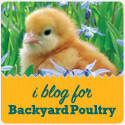Chicken Coop Chatter©
Chickens go back centuries on virtually all continents. Early artwork depicts chickens and it's been proven by science that the chicken evolved from the Tyrannosaurus as the nearest relative. With that in mind, maybe that's why we hear that cooked reptiles taste like chicken? I'll take the word of others for that.
Chickens are omnivores, they eat vegetation as well as meat. In early days chickens roamed free, and selected their own fare of berries, fruits, nuts, grains and carrion along with bugs and worms. Only modern man has seen fit to formulate special diets for chickens and provide containers with which to feed them.
Chickens are very industrious and most breeds are adept at foraging for their food without intervention of man, which is not unlike the wild birds we see going about their daily business of eating what they find in grass and weeds. They are adept at finding their own shelter, making nests in hidden shrubbery as well as hatching and raising their chicks; all without the aid of humans or the aid of modern conveniences such as electricity.
Knowing that chicken ancestry is embedded in literally all cultures around the world and much of the world until the 20th century had no power, yet chickens survived through harsh winters, and harsh summers without heat and without fans or air conditioners. Your own ancestors likely raised chickens for their food value and most of those were not housed in coops or protected by chicken wire, yet they continued to raise the chickens and allow them to do what they do best; forage, breed, and raise more of their own kind. Even the poorest of families had chickens when they could not afford other livestock. Slaves were allowed to care for chickens and many of the plantation owners allowed them to keep those chickens as their own. Chickens were food either for meat or eggs, or both, they were bartering material and a small income from egg sales.
As cultures began to explore new lands, chickens were taken along on the voyages as a food source and for purpose of barter. Our own Pilgrims brought chickens with them when they sought refuge on the North American soil. The early pioneers carried chickens on the wagon trains or prairie schooners, through unknown territory and grueling miles of uncertain terrain. When the exploration ships reached the ports or anchored; the remaining chickens were bartered or released to the land, where they mingled with other fowl of their kind; yet of other breeds. These chickens became known as landrace breeds because they lived off the land, and few humans actually raised them, but no doubt caught some for the meat and gathered eggs as they came across them. Because of the intermingling of the different chicken breeds, the general makeup of those chickens was altered in structure, color and feather pattern. As a result virtually all breeds of chickens are a crossbreed and in fact multiple crosses.
If you research chicken breeds, you will find in that information, a variety of other breeds that were involved in the makeup of your favorite breed of chicken. Modern breeding programs continue to cross breed for hybrid vigor, bigger and better, hardier, more colorful, and better overall production.
The British and French Aristocrats basically were the first to raise chickens for beauty and stature. Which they continue today and have very sophisticated exhibitions, with stiff competitions of their fine feathered creations. Prince Charles conducts a prestigious annual seminar for raising and exhibiting chickens, and the Queen Mother, raised prized Orpingtons for exhibition, which has recently been re-established and a young man is the honorary Royal Orpington keeper.
Believe it or not, electricity was not as widespread in this nation or the world as we would prefer to believe. Even into the 1930s,many farms still did not have electricity.
You may wonder how people may have tended their chickens and hatched chicks without electricity, if not for broody hens and modern trappings. Back in the early years, the power companies were small privately owned companies that serviced only small areas. Many farms were far from the cities, and it was too costly to even consider reaching them all. At that time, not unlike today, many private farmers and ranchers were barely making a living and power was simply an amenity they could not afford, so there was no incentive for the power companies to take the power lines into the far reaching farm lands. We talk today of *living off the grid*, but there are still locations that do not have power.
Some areas rely upon generators, windmills and portable power stations for power generation and limited to specific hours each day for them to operate. Our oldest sis lived in more than one place into the 1960s where a portable power plant was used; where water was hand pumped from wells and outhouses were the norm. There are homesteads that still exist that are not on the power grids in remote sections of this country. So in spite of what we think is a modern movement and way of thinking as an urge to get back to the land, there are some in our country that have lived this way for generations, even though today the power companies are huge conglomerates, there's little incentive to run a power line 10 or more miles into far reaching areas and cost prohibitive to do so, since those ranchers and farmers could not afford to pick up the tab to have it brought into their farm house. We've looked at property, where there may be a 10 or more mile stretch, to connect to the nearest power pole, and the land owner pays for every mile of that line. So living off the grid is not a new concept and some have never known the conveniences of power; unlike the cities and suburbs that are in a panic if the lights dim periodically.
With some research I found some very interesting information that goes back centuries on hatching methods, long before any type of electricity was available. I read an interesting article about early methods of egg incubation, some 3000 years ago, and wrote a short article about it a year ago.
China and Egypt, both had a method of incubation, using mud buildings they heated, by burning straw, manure or charcoal. Probably not unlike a meat smokehouse. They incubated thousands of eggs by this method. The egg managers lived in the buildings, and turned the eggs twice a day. They regulated the temperature by their own sense of warmth or chill and tested the temperature of the eggs by placing against their eyelid. Both cultures documented their incubation methods as early as 300 BC. Another early method of incubation was by placing eggs in composting manure piles. Since manure piles can reach temperatures over 100 degrees, I can see how a compost pile could work for incubation, if you could regulate the temperature and keep draft off the eggs.
Another more modern method of incubation I read about was using kerosene lamps, something like a distillery, where the tubes ran from the incubation box around the kerosene lamp, emitting heat; extracting excess moisture via the attached drip tube. Lehman's catalog has a replica of the early incubator and you will find that link below.
It wasn't until the 19th century that thermometers were available so temperatures could be regulated. But there were even commercial incubators available in the latter part of the 19th century, capable of hatching up to 400 eggs at a time; some of those were powered by kerosene and bellows and the eggs were hand turned by grids. Some of the old incubators were quite attractive in furniture style wood cabinets.
In the 20th century; at the earliest, 1911 there was an electrically powered incubator, but was not until about 1960 the more modern methods of incubation became available for more widespread use of incubators, rather than broody hens or by using the less accurate methods. Of course now you can purchase incubators with automated turning trays, fans to distribute the air, digital readings, scientific hygrometers for humidity and medical thermometers for temperature readings and multiple sized incubators to hatch from three to hundreds of fertile eggs, right in your own home, school or office throughout the year. Commercial incubators can hatch thousands of eggs at a time, all powered by electricity.
There's much to be said about the modern convenience of electricity, but there is a down side as well. We've personally had the experience of the loss of power during incubation. If the power is off very long, you risk the loss of those unhatched chicks and in fact chicks in brooders that rely upon heat to stay warm. There are things you can do to protect them for a time. You can power up a portable generator and keep it running to maintain the heat if you are prepared and able to spring into action. You can wrap your incubator in a heavy towel or blanket or survival blanket to maintain as much heat as possible. You can devise a shield to protect the incubator and brooder from any drafts as the air chills from lack of heat, and cover the brooder with a blanket to maintain warmth. You can light your wood stove and hurricane lamps to help maintain some warmth near the incubator and brooders.
What you need to be aware of is that you still must maintain a near optimum heat and humidity and if your incubator is a digital operating one with an automatic egg turner, you must make sure that turner does not come back on or reset when the power comes back on if you were in lockdown when the power outage occurred. We caution you about all of these things, because we have personally had these experiences. You risk losing an entire hatch and an entire brooder of chicks if you are not prepared for a power outage, particularly in the colder months of the year.
What ever your method of preparation, always use caution when you are using flammables around an incubator and particularly a brooder. Never set a brooder too close to a wood burning stove if the power were to be down. Always monitor the brooder but do not remove the blanket or allow drafts to enter while the power is down. If you are using oil lamps keep all flammables away from those lamps. So while preparing for outages, also use every precaution so you are not risking fire hazards.
Though most of us are dependent upon electricity, one power outage while incubating can make you very aware of what it must have been like at another time in human history when incubation of fertile eggs was being conducted entirely without the conveniences of power and a greater sense of respect for our ancestors that raised chickens without those conveniences and for the intended purposes of survival.
To read the entire article about Egypt and China, with reference to documents, visit: http://www.thepoultrysite.com/focus/contents/ceva/OnlineBulletins/ob_2005/Article-No2-Sept05.pdf
To see an example and perhaps order a kerosene incubator see: https://www.lehmans.com/p-1273-kerosene-powered-chicken-egg-incubator.aspx
Interesting article on antique poultry equipment and of particular note, early incubators: http://www.farmcollector.com/equipment/antique-incubators.aspx
Chicken Coop Chatter© All Rights Reserved 2011-2017

 RSS Feed
RSS Feed





